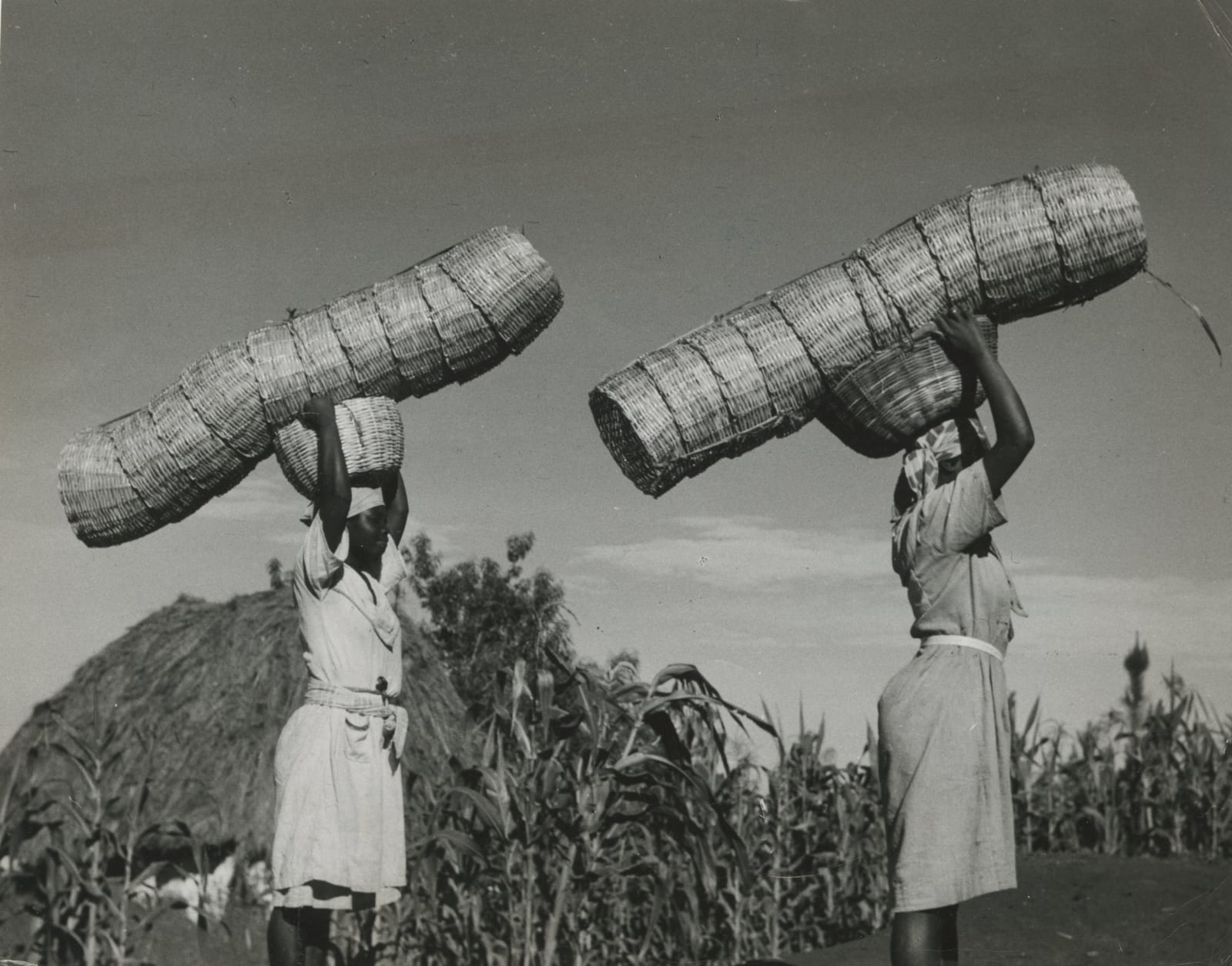Byron Coroneos
Collection of Photos of Haiti, 1940s-50s
Silver prints (32)
Most 7 ½ x 9 inches or slightly smaller
Each with photographer's credit and typed or affixed caption verso.
Each with photographer's credit and typed or affixed caption verso.
Sold
Further images
-
(View a larger image of thumbnail 1
)
![[Rodney King], Dramatic Aerial Views of the Los Angeles Uprising, 1992](https://artlogic-res.cloudinary.com/w_150,h_150,c_fill,f_auto,fl_lossy,q_auto/artlogicstorage/dollc/images/view/6d0d280749f3355bef51f2ecbb0130f2j/daniel-oliver-byron-coroneos-collection-of-photos-of-haiti-1940s-50s.jpg)
-
(View a larger image of thumbnail 2
)
![[Rodney King], Dramatic Aerial Views of the Los Angeles Uprising, 1992](https://artlogic-res.cloudinary.com/w_150,h_150,c_fill,f_auto,fl_lossy,q_auto/artlogicstorage/dollc/images/view/94da6659656e471e6846856fb136e64cj/daniel-oliver-byron-coroneos-collection-of-photos-of-haiti-1940s-50s.jpg)
-
(View a larger image of thumbnail 3
)
![[Rodney King], Dramatic Aerial Views of the Los Angeles Uprising, 1992](https://artlogic-res.cloudinary.com/w_150,h_150,c_fill,f_auto,fl_lossy,q_auto/artlogicstorage/dollc/images/view/37430c655f31839c7b2c1e510899f80bj/daniel-oliver-byron-coroneos-collection-of-photos-of-haiti-1940s-50s.jpg)
-
(View a larger image of thumbnail 4
)
![[Rodney King], Dramatic Aerial Views of the Los Angeles Uprising, 1992](https://artlogic-res.cloudinary.com/w_150,h_150,c_fill,f_auto,fl_lossy,q_auto/artlogicstorage/dollc/images/view/ba628223b547a2174f3e6a6a8e5070bfj/daniel-oliver-byron-coroneos-collection-of-photos-of-haiti-1940s-50s.jpg)
-
(View a larger image of thumbnail 5
)
![[Rodney King], Dramatic Aerial Views of the Los Angeles Uprising, 1992](https://artlogic-res.cloudinary.com/w_150,h_150,c_fill,f_auto,fl_lossy,q_auto/artlogicstorage/dollc/images/view/bb874ca03e3764e9339975dc46c11950j/daniel-oliver-byron-coroneos-collection-of-photos-of-haiti-1940s-50s.jpg)
-
(View a larger image of thumbnail 6
)
![[Rodney King], Dramatic Aerial Views of the Los Angeles Uprising, 1992](https://artlogic-res.cloudinary.com/w_150,h_150,c_fill,f_auto,fl_lossy,q_auto/artlogicstorage/dollc/images/view/12d2894d48044bae663e13fc15c175e1j/daniel-oliver-byron-coroneos-collection-of-photos-of-haiti-1940s-50s.jpg)
-
(View a larger image of thumbnail 7
)
![[Rodney King], Dramatic Aerial Views of the Los Angeles Uprising, 1992](https://artlogic-res.cloudinary.com/w_150,h_150,c_fill,f_auto,fl_lossy,q_auto/artlogicstorage/dollc/images/view/380405ee165de80b72c1e860f4f2fc9bj/daniel-oliver-byron-coroneos-collection-of-photos-of-haiti-1940s-50s.jpg)
-
(View a larger image of thumbnail 8
)
![[Rodney King], Dramatic Aerial Views of the Los Angeles Uprising, 1992](https://artlogic-res.cloudinary.com/w_150,h_150,c_fill,f_auto,fl_lossy,q_auto/artlogicstorage/dollc/images/view/9d0d7fe128a2b53d64a4bcaf222390ddj/daniel-oliver-byron-coroneos-collection-of-photos-of-haiti-1940s-50s.jpg)
This beautifully shot and informative collection of 32 photographs shows the lives of Haitians in a time of political unrest just after the coup d’etat of 1946 and before the...
This beautifully shot and informative collection of 32 photographs shows the lives of Haitians in a time of political unrest just after the coup d’etat of 1946 and before the coming Duvalier dictatorship in 1957. The people of the former Republic of Haiti are seen in their daily lives as well as in celebration during Haitian Carnival. The collection celebrates the agricultural and artisanal industries of Haiti. The mills and field labor of their major exports such as coffee, sisal, and corn are featured, including images of the largest sisal farm at the time. One striking image shows a large, spiky sisal plantation against the wide open sky, the horizon dotted with distant hills. The goods are then taken into the bustling markets, where only women participate, and the informative texts attached on the backs of the photographs provide that many goods such as sisal woven sandals and handbags only cost a fraction of a dollar at the time.
The collection also captures the capital city, Port-au-Prince, during the Carnival festivities. Men and women dressed in extravagant costumes put their bounties on display–men carrying large sacks of coffee and women holding abundant fruit baskets. The Catholic practices are a mark of the Spanish and French colonialism that go beyond religion. Westernization can be seen in the clothing, and more frequently, the architecture of the public buildings in Port-au-Prince. One image taken in the Grand’Rue (main street) downtown shows billboards for Coca-Cola hanging high above the heads of the pedestrians. Another notable photograph shows the crown of Faustin Soulouque, the Emperor of Haiti in the mid 1800s.
Byron Coroneos was born January 28, 1921 in Perth, Australia. Coroneos is most known for his vibrant color photographs of New York City’s glowing shopfronts at nighttime in the 1960s. Before he occupied New York, he was present for the Hatian Revolution in 1946, which he photographed in detail from start to finish. He continued to live there for a brief period of time and many of his color photographs of Haiti landscapes, portraits, and architecture still circulate today as popular imagery on postcards. He died on January 12, 2011 in Nedlands, Australia.
The collection also captures the capital city, Port-au-Prince, during the Carnival festivities. Men and women dressed in extravagant costumes put their bounties on display–men carrying large sacks of coffee and women holding abundant fruit baskets. The Catholic practices are a mark of the Spanish and French colonialism that go beyond religion. Westernization can be seen in the clothing, and more frequently, the architecture of the public buildings in Port-au-Prince. One image taken in the Grand’Rue (main street) downtown shows billboards for Coca-Cola hanging high above the heads of the pedestrians. Another notable photograph shows the crown of Faustin Soulouque, the Emperor of Haiti in the mid 1800s.
Byron Coroneos was born January 28, 1921 in Perth, Australia. Coroneos is most known for his vibrant color photographs of New York City’s glowing shopfronts at nighttime in the 1960s. Before he occupied New York, he was present for the Hatian Revolution in 1946, which he photographed in detail from start to finish. He continued to live there for a brief period of time and many of his color photographs of Haiti landscapes, portraits, and architecture still circulate today as popular imagery on postcards. He died on January 12, 2011 in Nedlands, Australia.







